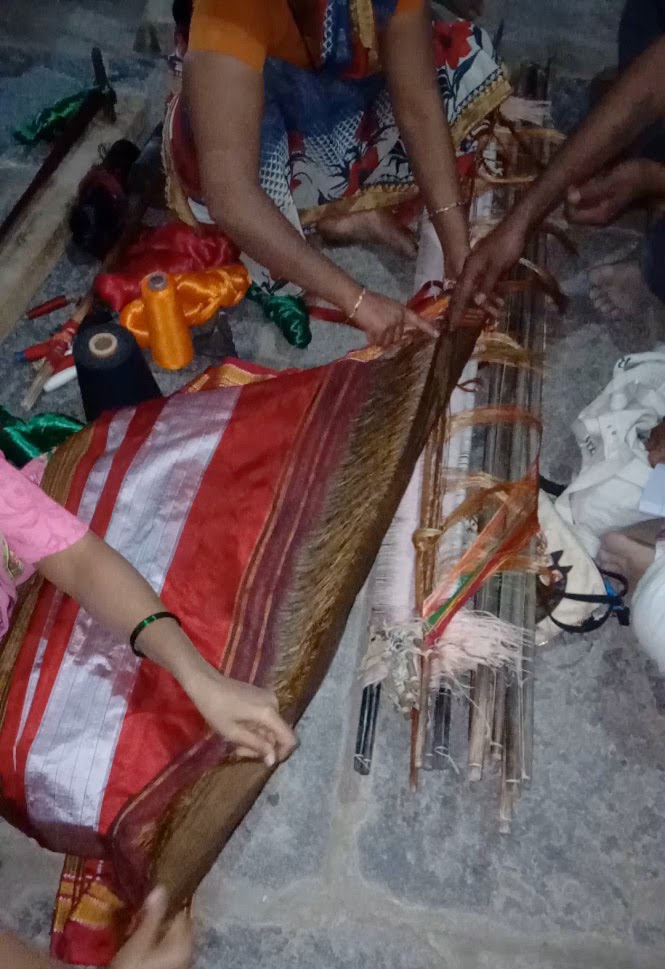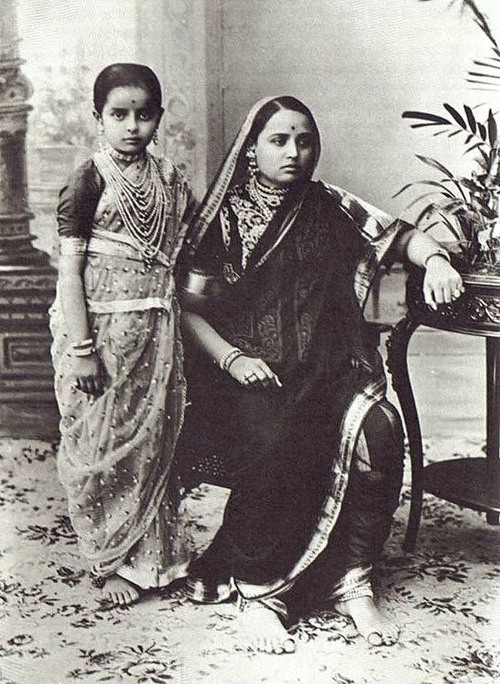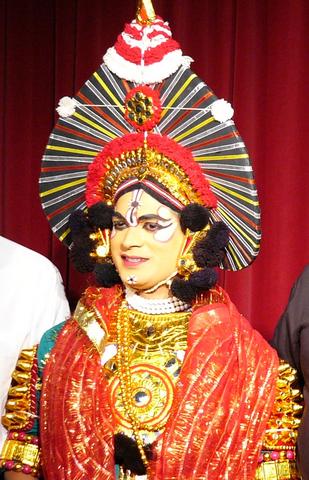|
Ilkal Saree
Ilkal sari is a traditional form of ''sari'' which is a common feminine wear in India. Ilkal sari takes its name from the town of Ilkal in the Bagalkot district of Karnataka state, India. Ilkal saris are woven using cotton warp on the body and art silk warp for border and art silk warp for pallu portion of the sari. In some cases instead of art silk, pure silk is also used. History Ilkal was an ancient weaving centre where the weaving seems to have started in the 8th century AD.Brief history of Ilkal saris is provided by The growth of these saris is attributed to the patronage provided by the local chieftains in and around the town of Bellary. The availability of local raw materials helped in the growth of this sari. About 20000 people in the town of Ilkal are engaged in sari-weaving.The history of Indian saris is discussed by Uniqueness * The uniqueness of sari is joining of the body warp with pallu warp with a series of loops locally called as TOPE TENI technique. * ... [...More Info...] [...Related Items...] OR: [Wikipedia] [Google] [Baidu] |
Weaving Ilkal Saree
Weaving is a method of textile production in which two distinct sets of yarns or threads are interlaced at right angles to form a fabric or cloth. Other methods are knitting, crocheting, felting, and braiding or plaiting. The longitudinal threads are called the warp and the lateral threads are the weft, woof, or filling. (''Weft'' is an Old English word meaning "that which is woven"; compare ''leave'' and ''left''.) The method in which these threads are interwoven affects the characteristics of the cloth. Cloth is usually woven on a loom, a device that holds the warp threads in place while filling threads are woven through them. A fabric band that meets this definition of cloth (warp threads with a weft thread winding between) can also be made using other methods, including tablet weaving, back strap loom, or other techniques that can be done without looms. The way the warp and filling threads interlace with each other is called the weave. The majority of woven products ar ... [...More Info...] [...Related Items...] OR: [Wikipedia] [Google] [Baidu] |
Sindhoor
Sindooram is a traditional vermilion red or orange-red coloured cosmetic powder from the Indian subcontinent, usually worn by married women along the part of their hairline. In Hindu communities the sindoor is a visual marker of marital status of a woman and ceasing to wear it usually implies widowhood. The main component of traditional sindooram is usually cinnabar (cinnabar is mercury sulfide, a toxic mineral), turmeric and lime. Some commercial sindoor products contain synthetic ingredients, some of which are not manufactured to proper standards and may contain lead. Application of sindoor Sindoor is traditionally applied at the beginning or completely along the parting-line of a woman’s hair (also called ''mang'' in Hindi or ''simandarekha'' in Sanskrit) or as a dot on the forehead. Sindoor is the mark of a married woman in Hinduism. Single women wear the bindi in different colours for special occasions but don't apply sindoor in their parting of the hairli ... [...More Info...] [...Related Items...] OR: [Wikipedia] [Google] [Baidu] |
Saris
A sari (sometimes also saree or shari)The name of the garment in various regional languages include: * as, শাৰী, xārī, translit-std=ISO * bn, শাড়ি, śāṛi, translit-std=ISO * gu, સાડી, sāḍī, translit-std=ISO * hi, साड़ी, sāṛī, translit-std=ISO * kn, ಸೀರೆ, sīre, translit-std=ISO * knn, साडी, कापड, चीरे, sāḍī, kāpaḍ, cīrē, translit-std=ISO * ml, സാരി, sāri, translit-std=ISO * mr, साडी, sāḍī, translit-std=ISO * ne, सारी, sārī, translit-std=ISO * or, ଶାଢ଼ୀ, śāṛhī, translit-std=ISO * pa, ਸਾਰੀ, sārī, translit-std=ISO * ta, புடவை, puṭavai, translit-std=ISO * te, చీర, cīra, translit-std=ISO * ur, ساڑى, sāṛī, translit-std=ISO is a women's garment from the Indian subcontinent, that consists of an un-stitched stretch of woven fabric arranged over the body as a robe, with one end tied to the waist, while ... [...More Info...] [...Related Items...] OR: [Wikipedia] [Google] [Baidu] |
Culture Of Karnataka
The southern state of India,Karnataka, has a distinct art and culture informed by a long history of diverse linguistic and religious ethnicity. Apart from Kannadigas, Karnataka is home to Tuluvas, who also consider themselves as Kannadigas. Minor populations of Tibetan Buddhists and Siddhi tribes plus a few other ethnic groups also live in. The traditional folk arts are major theatrical forms of coastal Karnataka. Contemporary theatre culture in Karnataka is one of the most vibrant in India with organizations like Ninasam, Ranga Shankara and Rang on foundations laid down by the Gubbi Veeranna Nataka Company. Veeragase, Kamsale and Dollu Kunitha are popular dance forms. Bharatanatya also enjoys wide patronage in Karnataka. Music Karnataka is the only Indian state where both Hindustani and Carnatic singers flourish. North Karnataka is predominantly famous for Hindustani music and South Karnataka is well known for Carnatic music. Carnatic music With the rise of Vaishnav ... [...More Info...] [...Related Items...] OR: [Wikipedia] [Google] [Baidu] |
Navalgund Durries
Navalgund durries, geographically tagged in India, are woven durries or a type of Indian rug with geometric designs, birds, and animal designs from Navalgund in Dharwad district of Karnataka, India This durrie has been registered for protection under the Geographical indication of the Trade Related Intellectual Property Rights (TRIPS) agreement. In 2011, it was listed as "Navalgund Durries" under the GI Act 1999 of the Government of India with registration confirmed by the Controller General of Patents Designs and Trademarks under Class 27 vide application number 61 of 27 June 2011. The logo for this durrie was registered under application number 512, dated 8 January 2015. Location Navalgund, where the hand-made Navalgund durries are made, is located within the geographical coordinates of . History Nuvulgund durrigullu, also known as "jumkhaanaa" gullu in Kannada language, were initially made by a group of weavers of Bijapur who used to live in the Jumkhaan Gulli during the re ... [...More Info...] [...Related Items...] OR: [Wikipedia] [Google] [Baidu] |
Mysore Sandal Soap
Mysore Sandal Soap is a brand of soap manufactured by the Karnataka Soaps and Detergents Limited (KSDL), a company owned by the government of Karnataka in India. This soap has been manufactured since 1916, when Krishna Raja Wadiyar IV, the king of Mysore, set up the Government Soap Factory in Bangalore. The main motivation for setting up the factory was the excessive sandalwood reserves that the Mysore Kingdom had, which could not be exported to Europe because of the First World War. In 1980, KSDL was incorporated as a company by merging the Government Soap Factory with the sandalwood oil factories at Shimoga and Mysore. Mysore Sandal Soap is the only soap in the world made from 100% pure sandalwood oil. KSDL owns a proprietary geographical indication tag on the soap, which gives it intellectual property rights to use the brand name, to ensure quality, and to prevent piracy and unauthorised use by other manufacturers. In 2006, Mahendra Singh Dhoni, the Indian cricket ... [...More Info...] [...Related Items...] OR: [Wikipedia] [Google] [Baidu] |
Byadagi Chilli
Byadagi chilli ( kn, ಬ್ಯಾಡಗಿ ಮೆಣಸಿನಕಾಯಿ) is a famous variety of chilli mainly grown in the Indian state of Karnataka. It is named after the town of Byadgi which is located in the Haveri district of Karnataka. It is sometimes written as Bedgi in some super markets and grocery stores in India. The business involving Byadagi chillis has the second largest turnover among all chilli varieties of India. An oil, oleoresin extracted from these chillies is used in the preparation of nail polish and lipsticks. Byadagi chilli is also known for its deep red colour and is less spicy and is used in many food preparations of South India. Byadagi chilli has been accorded Geographical Indication (GI) in February 2011. Its GI tag is 129. List of Geographical Indications in India Byadagi chillies come in two types: dabbi and kaddi. Byadagi dabbi, which is small and plump, is more popular for its colour, flavour and taste. Though it has more seeds, it is less spicy ... [...More Info...] [...Related Items...] OR: [Wikipedia] [Google] [Baidu] |
Bidriware
Bidriware is a metal handicraft from the city of Bidar in southern India. It was developed in the 14th century C.E. during the rule of the Bahmani Sultans. The term "bidriware" originates from the township of Bidar, which is still the chief center of production. The metal used is white brass that is blackened and inlaid with silver. This native art form has obtained Geographical Indications (GI) registry. Origins The origin of bidriware is usually attributed to the Bahamani sultans who ruled Bidar in the 14th–15th centuries. Bidriware techniques and style are influenced by Persian art. It was first brought to India by noted Sufi Khwaja Moinuddin Hasan Chisti in the form of utensils. The art form developed in the kingdom that was a mix of Turkish, Persian and Arabic influences which were intermingled with the local styles and thus a unique style of its own was born. Abdullah bin Kaiser, a craftsman from Iran was invited by the Sultan Ahmed Shah Bahmani to work on decorating ... [...More Info...] [...Related Items...] OR: [Wikipedia] [Google] [Baidu] |
Kasuti
Kasuti ( kn, ಕಸೂತಿ) is a traditional form of folk embroidery practised in the state of Karnataka, India. An exhibition of Kasuti work is reported by Kasuti work which is very intricate sometimes involves putting up to 5,000 stitches by hand and is traditionally made on dresswear like Ilkal sarees, Ravike/ Kuppasa(Khana) and Angi. The Karnataka Handicrafts Development Corporation (KHDC) holds a geographical indications (GI) protection for Kasuti embroidery which provides intellectual property rights on Kasuti to KHDC. History of Kasuti is mentioned by History The history of Kasuti dates back to the Chalukya period. The name ''Kasuti'' is derived from the words ''Kai'' (meaning hand) and ''Suti/suttu'' (meaning wrap/weave), indicating an activity that is done using cotton and hands. The origin of Kasuti is discussed by The women courtiers in the Mysore Kingdom in the 17th century were expected to be adept in 64 arts, with Kasuti being one of them. The Kasuti embroider ... [...More Info...] [...Related Items...] OR: [Wikipedia] [Google] [Baidu] |
Indian Woman Fruit Vendor
Indian or Indians may refer to: Peoples South Asia * Indian people, people of Indian nationality, or people who have an Indian ancestor ** Non-resident Indian, a citizen of India who has temporarily emigrated to another country * South Asian ethnic groups, referring to people of the Indian subcontinent, as well as the greater South Asia region prior to the 1947 partition of India * Anglo-Indians, people with mixed Indian and British ancestry, or people of British descent born or living in the Indian subcontinent * East Indians, a Christian community in India Europe * British Indians, British people of Indian origin The Americas * Indo-Canadians, Canadian people of Indian origin * Indian Americans, American people of Indian origin * Indigenous peoples of the Americas, the pre-Columbian inhabitants of the Americas and their descendants ** Plains Indians, the common name for the Native Americans who lived on the Great Plains of North America ** Native Americans in ... [...More Info...] [...Related Items...] OR: [Wikipedia] [Google] [Baidu] |








